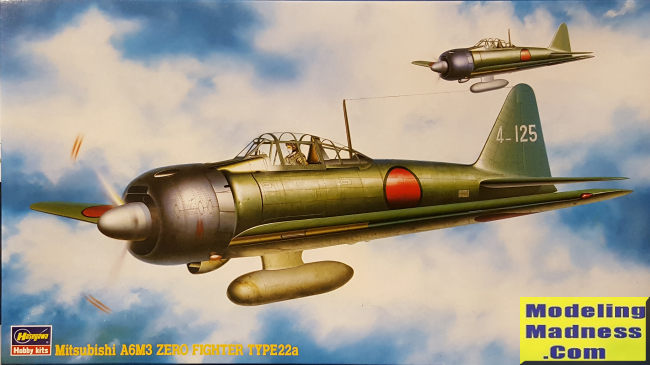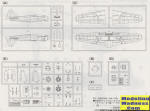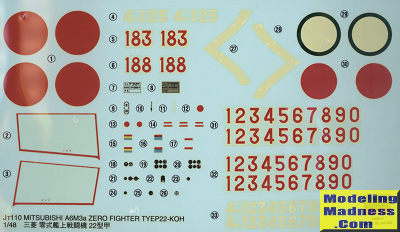
| KIT #: | 09170 (Jt110) |
| PRICE: | 2200 yen when new |
| DECALS: | Two units |
| REVIEWER: | Scott Van Aken |
| NOTES: | 1995 release |

| HISTORY |
The A6M3 model 32 was developed to provide improvements over the initial A6M2, which was a fairly successful aircraft. Changes included a more powerful (and heavier) engine which required shorter engine mounts and so less fuel in the forward fuel tank. Clipped wings were also part of the update. In addition, upgraded wing guns holding more ammunition also reduced fuel. Add these to the more thirsty engine and range was reduced by nearly 1,000 km and maneuverability was also somewhat sacrificed. Though not really liked by the navy, they bought 340 of them before switching to an improved model 22.
In order to correct the deficiencies of the Model 32, a new version with folding wingtips and redesigned wing was introduced. The fuel tanks were moved to the outer wings, fuel lines for a 330 l (87 US gal) drop tank were installed under each wing and the internal fuel capacity was increased to 570 l (150 US gal). More importantly, it regained its capabilities for long operating ranges, similar to the previous A6M2 Model 21, which was vastly shortened by the Model 32.
However, before the new design type was accepted formally by the Navy, the A6M3 Model 22 already stood ready for service in December 1942. Approximately 560 aircraft of the new type had been produced in the meantime by Mitsubishi Jukogyo K.K.
According to a theory, the very late production Model 22 might have had wings similar to the shortened, rounded-tip wing of the Model 52. One plane of such arrangement was photographed at Lakunai Airfield ("Rabaul East") in the second half of 1943, and has been published widely in a number of Japanese books. While the engine cowling is the same of previous Model 32 and 22, the theory proposes that the plane is an early production Model 52.
The Model 32, 22, 22 kou, 52, 52 kou and 52 otsu were all powered by the Nakajima 栄 (Sakae) 21型 engine. That engine kept its designation in spite of changes in the different exhaust system for the Model 52.
| THE KIT |
 The
A6M has been a popular subject for modelers since the beginning of plastic
modeling. The first really well done A6M was an A6M5 released by Tamiya in the
mid 1980s that sold extremely well. Hasegawa's series of A6Ms started production
in the early 1990s and continues today despite their being more detailed kits
currently available. The reason for this is simple. They are not complex,
provide a pretty nice cockpit right from the box, and are fairly easy to find.
Probably the biggest down side of many earlier releases is the decal sheet with
reds that are too bright and whites that are off-white. This kit has this issue.
The
A6M has been a popular subject for modelers since the beginning of plastic
modeling. The first really well done A6M was an A6M5 released by Tamiya in the
mid 1980s that sold extremely well. Hasegawa's series of A6Ms started production
in the early 1990s and continues today despite their being more detailed kits
currently available. The reason for this is simple. They are not complex,
provide a pretty nice cockpit right from the box, and are fairly easy to find.
Probably the biggest down side of many earlier releases is the decal sheet with
reds that are too bright and whites that are off-white. This kit has this issue.
Hasegawa has done a fine job of 'modularizing' this kit and you can find the same base sprues in most of their Zero boxings. External detailing is excellent and you are provided with a crystal clear canopy suite that allows you to pose the canopy open if you so desire. The cockpit is very nicely detailed and includes cockpit side panels. Decals are provided for the raised detail on the instrument panel and the side console. About the only thing lacking is a seat belt. Note that IJNAF planes usually had a three point harness like you have in your car and many pilots did not use the shoulder strap.
Once the cockpit is built, it is trapped between the fuselage halves. In fact, you can assemble the fuselage and install the cockpit from the underside through the wing opening. The insert for the cowling guns is one area that usually requires some extra attending when building the kit. You have a four piece engine assembly that fits to the front of the fuselage and the one-piece cowling fits over that. I'd leave both the engine and cowling off until the end to make painting easier.
Note that the small trim tabs on the rudder and
ailerons need to be removed. If you want to install a centerline drop tank,
holes must be opened in the lower wing. The instructions show holes just outside
the main gear wells being opened, and these are for the small cannon bulges.
Before attaching the wing, an insert for the carb intake needs to be installed.
On the underside, landing gear and gear doors are fit into place. The long
barrel wing guns and tail hook are put in place. Other items to assemble are the
five piece prop assembly , that attachment of the DF loop antenna, radio mast
and the clear bits. Note that many of the Zeros in the South Pacific had the
radios and the mast removed so check your references.

Instructions are standard Hasegawa of the time and use Gunze paint references. Two units are provided with tail numbers for multiple aircraft. The box art plane is listed as an unknown unit, though subsequently has been determined to be one of the 'Rabaul Kokutai' using available planes. The other is from the 582nd Kokutai. Both planes are in a dark green over ameiro. The decals are 'old school' and while they still may work well, it would be prudent to find replacements.
| CONCLUSIONS |
If you want a fairly easy kit to build that has good detail, then this would be a good kit for you. I've built quite a few Hasegawa Zeros and have been pleased with each one of them.
| REFERENCES |
https://en.wikipedia.org/wiki/Mitsubishi_A6M_Zero
December 2021
Copyright ModelingMadness.com. All rights reserved. No reproduction in
part or in whole without express permission.
If you would like your product reviewed fairly and fairly quickly, please
contact
the editor or see other details in the
Note to
Contributors. Back to the Main Page
Back to the Review
Index Page
Back to the Previews Index Page